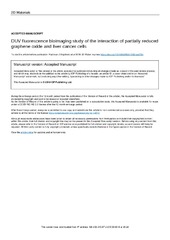Приказ основних података о документу
DUV fluorescence bioimaging study of the interaction of partially reduced graphene oxide and liver cancer cells
| dc.creator | Dojčilović, Radovan | |
| dc.creator | Pajović, Jelena D. | |
| dc.creator | Božanić, Dušan K. | |
| dc.creator | Jović, Nataša | |
| dc.creator | Pavlović, Vera P. | |
| dc.creator | Pavlović, Vladimir | |
| dc.creator | Lenhardt-Acković, Lea | |
| dc.creator | Zeković, Ivana | |
| dc.creator | Dramicanin, Miroslav D. | |
| dc.creator | Kascakova, Slavka | |
| dc.creator | Refregiers, Matthieu | |
| dc.creator | Rasić, Goran | |
| dc.creator | Vlahović, Branislav | |
| dc.creator | Djoković, Vladimir | |
| dc.date.accessioned | 2020-12-17T22:13:18Z | |
| dc.date.available | 2020-12-17T22:13:18Z | |
| dc.date.issued | 2018 | |
| dc.identifier.issn | 2053-1583 | |
| dc.identifier.uri | http://aspace.agrif.bg.ac.rs/handle/123456789/4655 | |
| dc.description.abstract | The interaction of partially reduced graphene oxide (prGO) and Huh7.5.1 liver cancer cells was investigated by means of DUV fluorescence bioimaging. The prGO sample was obtained by the reduction (to a certain extent) of the initially prepared graphene oxide (GO) nanosheets with hydrazine. The fluorescence of the GO nanosheets increases with time of the reduction due to a change in ratio of the sp(2) and sp(3) carbon sites and the prGO sample was extracted from the dispersion after 6 min, when the intensity of the fluorescence reached its maximum. The reduction process was left to proceed further to saturation until highly reduced graphene oxide (denoted here as rGO) was obtained. GO, prGO and rGO samples were investigated by structural (scanning electron microscopy (SEM), scanning transmission electron microscopy coupled with energy dispersive spectrometry (STEM-EDS)) and spectroscopic (UV-vis, photoluminescence (PL), Raman) methods. After that, Huh7.5.1 cells were incubated with GO, prGO and rGO nanosheets and used in bioimaging studies, which were performed on DISCO beamline of synchrotron SOLEIL. It was found that the prGO significantly enhanced the fluorescence of the cells and increased the intensity of the signal by similar to 2.5 times. Time-lapse fluorescence microscopy experiments showed that fluorescence dynamics strongly depends on the type of nanosheets used. The obtained prGO nanostructure can be easily conjugated with aromatic ring containing drugs, which opens a possibility for its applications in fluorescence microscopy monitored drug delivery. | en |
| dc.publisher | IOP Publishing Ltd, Bristol | |
| dc.relation | NSF CRESTNational Science Foundation (NSF)NSF- Directorate for Education & Human Resources (EHR) [HRD-0833184] | |
| dc.relation | NASANational Aeronautics & Space Administration (NASA) [NNX09AV07A] | |
| dc.relation | info:eu-repo/grantAgreement/MESTD/Basic Research (BR or ON)/172056/RS// | |
| dc.relation | info:eu-repo/grantAgreement/MESTD/Integrated and Interdisciplinary Research (IIR or III)/45020/RS// | |
| dc.relation | info:eu-repo/grantAgreement/MESTD/Basic Research (BR or ON)/171029/RS// | |
| dc.rights | openAccess | |
| dc.source | 2d Materials | |
| dc.subject | bioimaging | en |
| dc.subject | graphene oxide | en |
| dc.subject | fluorescence | en |
| dc.subject | cancer | en |
| dc.subject | cells | en |
| dc.title | DUV fluorescence bioimaging study of the interaction of partially reduced graphene oxide and liver cancer cells | en |
| dc.type | article | |
| dc.rights.license | ARR | |
| dc.citation.issue | 4 | |
| dc.citation.other | 5(4): - | |
| dc.citation.rank | M21 | |
| dc.citation.volume | 5 | |
| dc.identifier.doi | 10.1088/2053-1583/aad72b | |
| dc.identifier.fulltext | http://aspace.agrif.bg.ac.rs/bitstream/id/3180/4652.pdf | |
| dc.identifier.scopus | 2-s2.0-85054724220 | |
| dc.identifier.wos | 000441754800003 | |
| dc.type.version | publishedVersion |


